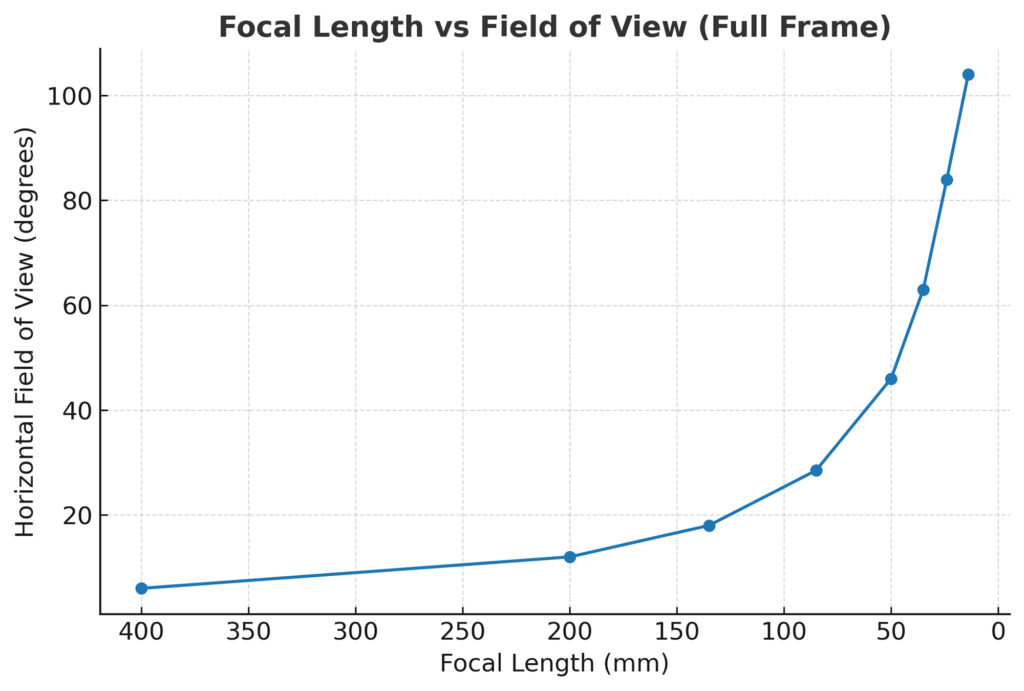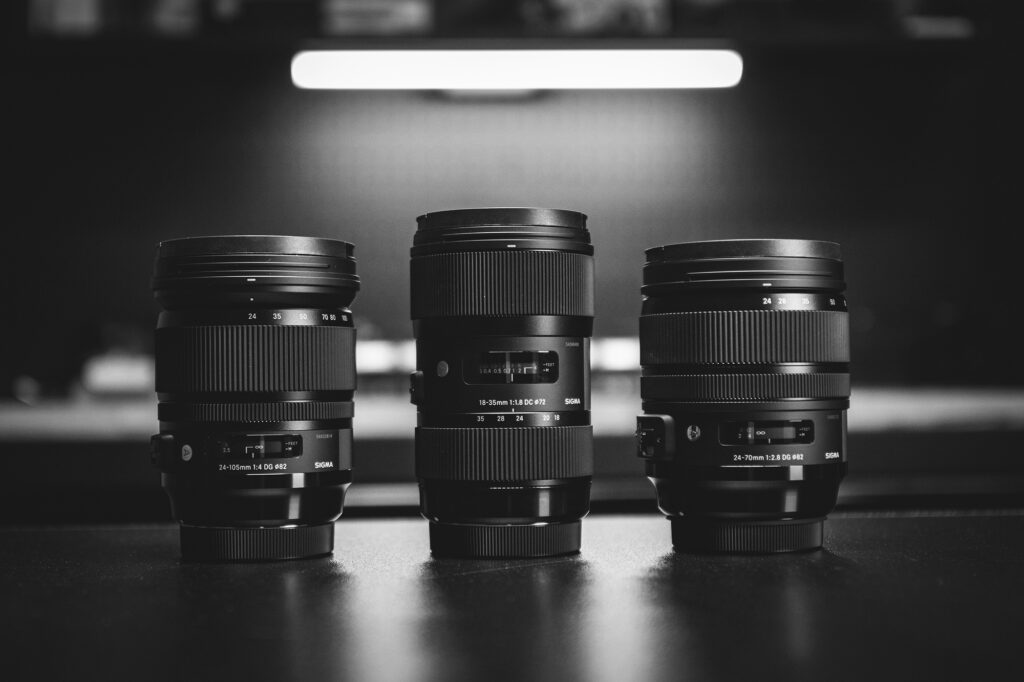Buying a lens can feel overwhelming when you’re met with a wall of technical terms, abbreviations, and numbers. What’s the difference between f/1.8 and f/4? What do “IS” or “STM” mean? Is a 50mm better than a 24-70mm? In this post, we’ll break down the most important camera lens terminology for beginners. By the end, you’ll understand how to read lens specs like a pro and choose the right lens for your needs.
And once you know the terminology, you’ll find it easier to explore the different types of camera lenses available.
TL;DR
- Focal length controls how wide or zoomed-in your shot looks.
- Aperture (f-stop) affects brightness and depth of field.
- Prime lenses have fixed focal lengths; zoom lenses are more flexible.
- Lens mounts must match your camera body (or use an adapter).
- Image stabilization helps reduce blur from hand movement.
- Autofocus motors affect how fast and quiet the lens focuses.
- Focus-by-wire is common in mirrorless systems, especially for video.
- Internal zoom/focus keeps the lens compact and weather-resistant.
- Minimum focus distance determines how close you can shoot.
- Filter thread size matters if you plan to use ND, UV, or other types if filters.
- Weather sealing makes a lens more resistant to rain and dust.
- Lens elements and coatings improve image quality and reduce flares.
This post is just one part of my “Lens Buying Guide“, which you can download as a pdf file right now.
1. Focal Length (What It Is and Why It Matters)
The focal length of a lens -measured in millimeters (mm)- determines two essential things: how wide or narrow your field of view is, and how much magnification (or zoom) you get. The longer the focal length, the narrower the field of view and the greater the magnification. The shorter the focal length, the wider your view.
A common misconception is that focal length is the physical distance between the front of the lens and the camera sensor. In reality, it’s the distance from the sensor to the lens’s optical convergence point: the spot inside the lens where light rays meet to form an image. This point varies depending on the lens design.
Lenses are categorized based on their focal length. We’ll break down those categories shortly.
Important: The number written on a lens (e.g., 50mm) refers to its nominal focal length, but the effective focal length depends on the sensor size of your camera. The same 50mm lens behaves differently on a full-frame camera versus a crop-sensor (APS-C) body.
For example, a 50mm lens on a full-frame sensor gives you a true 50mm field of view. But on a crop-sensor camera with a 1.6× crop factor, it gives you an equivalent of 80mm, which is more zoomed in. APS-C sensors typically have a 1.5× or 1.6× crop factor.
That’s why compact cameras with smaller sensors can offer high zoom ranges in very small bodies: their crop factor multiplies the effective focal length.
To calculate effective focal length, multiply the lens’s focal length by the crop factor of your camera.
Another important effect of focal length is background compression. Telephoto lenses (longer focal lengths) make the background appear larger and closer to the subject than it really is. This creates a pleasing, compressed look that’s especially useful for portrait and wildlife photography, where you want the subject to stand out while the background feels soft and distant. On the other hand, wide-angle lenses exaggerate depth and space, making background elements appear farther away.

2. Aperture and f-Stop: How Bright Is Your Lens?
Aperture works like the pupil of your eye: it controls how much light passes through the lens and hits the sensor. In low light, your pupil dilates; lenses behave similarly by widening the aperture to let in more light.
Aperture size is represented using f-numbers or f-stops (e.g., f/1.8, f/4, f/11). The smaller the f-number, the wider the aperture and the more light reaches the sensor. A higher f-number means a smaller aperture and less light.
For example, f/1.8 allows more light than f/4.
But aperture affects more than just brightness. It also determines depth of field, or how much of the image is in focus. Wider apertures (like f/1.8) give you a shallower depth of field, which means only a narrow area will be sharp, while the background is nicely blurred. This is a desirable effect for portrait photography in many conditions, giving your photos a more professional look.
Each lens has a maximum and minimum aperture, often listed in the lens name. Zoom lenses often show a range, like f/3.5-5.6, meaning f/3.5 is the widest aperture at the wide end of the zoom, and f/5.6 is the widest aperture at the telephoto end.
Lenses with wider maximum apertures (lower f-numbers) are usually more expensive. But they also give you more creative flexibility, especially in low light.
Pro tip: When someone says a lens is “fast,” they’re referring to its wide aperture, like f/1.8 or f/1.4, which allows faster shutter speeds in low light.
If you want to understand how aperture fits into the bigger picture, my guide to the exposure triangle breaks it down step-by-step.
3. Prime vs. Zoom Lenses: Which Should You Choose?
Lenses are divided into two main categories based on focal length flexibility:
- Zoom lenses let you change focal length, allowing you to zoom in or out by rotating a zoom ring.
- Prime lenses have a fixed focal length, meaning the field of view and magnification never change.
Prime lenses often offer better image quality and lower f-numbers (wider apertures) at the same price point. They’re typically sharper, lighter, and better in low light. Zooms are more versatile and convenient -especially for everyday or travel use- but may sacrifice some sharpness or speed unless you invest in high-end models.
4. Lens Mount Compatibility: Will It Fit Your Camera?
Your lens must be compatible with your camera’s mount: the physical connection point between the lens and the body. Each brand (Canon, Nikon, Sony, etc.) uses its own lens mount systems, and many manufacturers have different mounts even within their own lineup (e.g., Canon EF vs. RF).
That’s why the best lens for your camera is often one made by the same brand.
Some lenses from other brands (like Sigma, Tamron, Viltrox, etc.) are made for specific mounts and can work just as well. There are also lens adapters that let you use incompatible lenses on your camera body, but these often come with limitations. You may lose autofocus or stabilization, and some adapters reduce the amount of light reaching the sensor (by a few stops).
So if possible, stick with native mount lenses, or do thorough research before using third-party or adapted glass.
5. Image Stabilization (IS / VR / OSS, etc.)
In mirrorless and compact cameras, image stabilization is often built into the camera body. But in DSLRs, it’s more common for stabilization to be built into the lens.
Each camera brand has its own stabilization system, and their naming conventions differ. For example, Sony uses OSS (Optical SteadyShot), Nikon calls it VR (Vibration Reduction), Canon calls it IS (Image Stabilization), and so on. You’ll usually find these abbreviations in the lens model name.
Stabilization is measured in stops. A lens with “3-stop” stabilization allows you to shoot at shutter speeds up to 3 stops slower than what you’d typically need, without introducing noticeable blur from camera shake.
As a rule of thumb, your shutter speed should be at least 1 divided by your focal length to avoid blur. So for a 50mm lens, you’d want at least 1/50s. With stabilization, you could get away with something like 1/10s or 1/6s: handy in low light or handheld shooting.
However, take manufacturers’ stabilization claims with a grain of salt. The real-world performance is often a bit lower.
6. Autofocus Motors (USM, STM, XD, etc.)
Not all autofocus systems are created equal. Some lenses use faster and quieter motors, like Sony’s SSM (Super Sonic wave Motor), Nikon’s SWM (Silent Wave Motor), or Canon’s USM (Ultrasonic Motor). These motors make a big difference in fast-paced shooting scenarios like sports or wildlife photography, and are also ideal for video, where focus noise can be distracting.
On the other hand, more basic lenses often use slower and noisier motors, which may hunt back and forth when trying to lock focus.
If autofocus speed or silence matters to you -especially for video- be sure to check what kind of motor a lens uses.
7. Focus-by-Wire vs. Mechanical Focus Rings
Many newer mirrorless lenses use electronic focus systems, called “focus-by-wire.” Instead of directly moving the lens elements when you turn the focus ring, the ring sends a signal to a motor, which then adjusts the focus.
While this can feel smooth and modern, some photographers (especially those who shoot manual focus video or macro) prefer mechanical focus for its precision and tactile feedback.
If you plan to do a lot of manual focusing, it’s worth checking whether a lens uses true mechanical focus or focus-by-wire.
8. Internal vs. External Zoom and Focus Mechanisms
Some lenses change length when you zoom or focus, extending outward. Others keep their physical size constant. The latter are called internal zoom or internal focus lenses.
Why it matters:
- Internal systems are better sealed against dust and moisture
- They’re easier to balance on a gimbal or rig
- The lens size doesn’t shift during operation (ideal for video setups)
While not a deal-breaker for everyone, internal mechanisms are often preferred by professionals working in dynamic or outdoor environments.
9. Minimum Focus Distance (And Why Macro Isn’t Just About Zoom)
Every lens has a minimum focusing distance: the closest distance from which it can focus on a subject. If something is closer than that distance, the lens simply can’t focus on it.
Generally, the longer the focal length, the greater the minimum focus distance. While this usually isn’t a big issue for most types of photography, it can become important if you plan to shoot close-ups, macro, food, or product photography.
If you often work at close range, pay attention to this spec when choosing a lens.
10. Filter Thread Size: What Filters Will Fit This Lens?
The front diameter of a lens determines the filter size you need, such as for ND filters, polarizers, or UV protection. This is different from the lens mount diameter, which connects the lens to the camera body.
Screw-on (circular) filters are the most common and affordable. They attach directly to the front of your lens. Filter size is usually printed on the front of the lens with a “Ø” symbol. And it’s measured in millimeters, for example, 58mm, 72mm, or 82mm.
Some sizes are more common than others. If you have multiple lenses and want to use the same filters across them, consider choosing lenses with matching or adaptable filter threads. Filters -especially high-quality ones- can be expensive, so this spec can matter more than you might expect.
11. Weather Sealing: Is Your Lens Built for the Elements?
Many newer lenses are designed with weather sealing, meaning they are built to resist moisture, dust, and light rain. These lenses have rubber gaskets and tight seals where they attach to the camera body to prevent environmental elements from reaching the sensor or internal lens components.
Weather-sealed lenses are ideal for outdoor, travel, nature, or street photographers who frequently shoot in unpredictable conditions.
That said, no lens is indestructible. Even with sealing, avoid exposing your gear to extreme conditions unless absolutely necessary. Still, having a weather-resistant lens can give you more confidence and flexibility when shooting outdoors.
12. Optical Elements and Coatings (ED, ASPH, Nano, etc.)
Higher-end lenses often include special glass elements and advanced coatings that reduce image issues like chromatic aberration, color fringing, and lens flare.
For example:
- Sony includes Nano AR Coating to reduce reflections
- Nikon uses ED (Extra-low Dispersion) glass
- Canon has UD (Ultra-low Dispersion) and Fluorite elements
- Sigma offers FLD and SLD glass
These enhancements help improve sharpness, contrast, and clarity, especially in challenging lighting. It’s part of what makes some lenses much more expensive than others with similar specs.
13. What Do the Letters in Lens Names Mean?
As mentioned earlier, lens names usually begin with the focal length (or range, for zoom lenses) and the maximum aperture. But almost all lenses also have additional letters or abbreviations in their model names, usually acronyms that indicate specific features or technologies.
These letters can help you identify whether a lens includes image stabilization, a special optical design, silent autofocus, or weather sealing, among other things.
Each brand uses its own terminology, and these codes are not always intuitive. But understanding them will make choosing the right lens much easier. You can see some of these abbreviations below. Just remember that they change over time and from one series of lenses to the next.
| Brand Name | Abbreviation | Meaning (What It’s Short For) | What It Indicates |
| Sony | FE | Full-frame E-mount | Lens is designed for full-frame Sony E-mount cameras |
| Sony | E | E-mount | Lens is designed for APS-C Sony E-mount cameras |
| Sony | G | Gold | High-quality optics, premium build |
| Sony | GM | G Master | Sony’s top-tier professional lens series |
| Sony | OSS | Optical SteadyShot | Lens has built-in image stabilization |
| Sony | PZ | Power Zoom | Electronically controlled zoom mechanism |
| Sony | ZA | Zeiss Alpha | Collaborative lenses with Zeiss for Sony Alpha cameras |
| Nikon | AF-S | Auto Focus with Silent wave motor | Faster, quieter autofocus mechanism |
| Nikon | AF-P | Auto Focus with Pulse motor | Quieter, smoother autofocus (great for video) |
| Nikon | FX | Full-frame sensor format | Lens is designed for full-frame Nikon cameras |
| Nikon | DX | Digital Format | Lens is designed for APS-C Nikon cameras |
| Nikon | VR | Vibration Reduction | Lens has image stabilization |
| Nikon | Z | Z-mount | For Nikon mirrorless cameras |
| Nikon | S | S-Line | Premium Z-mount lens series |
| Canon | EF | Electro-Focus | For Canon full-frame and APS-C DSLRs |
| Canon | EF-S | Electro-Focus Short back focus | For Canon APS-C DSLRs only |
| Canon | RF | Re-Focus | For Canon full-frame mirrorless cameras |
| Canon | IS | Image Stabilizer | Built-in optical image stabilization |
| Canon | USM | Ultrasonic Motor | Fast, quiet autofocus motor |
| Canon | STM | Stepping Motor | Smooth, quiet focus motor (ideal for video) |
| Canon | L | Luxury | Canon’s professional-grade lens line |
| Panasonic / Leica | LUMIX | Luminary Mix | Panasonic digital camera brand |
| Panasonic / Leica | X | Extra performance | High-end Panasonic lenses |
| Panasonic / Leica | O.I.S. | Optical Image Stabilizer | Built-in stabilization |
| Panasonic / Leica | LEICA | Leitz Camera | Leica-designed optics |
| Panasonic / Leica | L | L-mount | For Panasonic/Leica full-frame mirrorless systems |
| Fujifilm | XF | X-mount Fine | Premium lenses for APS-C X-mount cameras |
| Fujifilm | XC | X-mount Compact | Budget-friendly lenses for APS-C X-mount |
| Fujifilm | LM | Linear Motor | Fast, quiet autofocus motor |
| Fujifilm | OIS | Optical Image Stabilization | Built-in stabilization |
| Fujifilm | WR | Weather Resistant | Sealed against dust and moisture |
| Sigma | DG | Digital Grade | Designed for full-frame cameras |
| Sigma | DC | Digital Compact | Designed for APS-C cameras |
| Sigma | DN | Digital Neo | Designed for mirrorless cameras |
| Sigma | HSM | Hyper Sonic Motor | Fast and quiet autofocus motor |
| Sigma | OS | Optical Stabilizer | Built-in image stabilization |
| Sigma | Art | Art series | High-performance lenses for artistic expression |
| Sigma | Contemporary | Contemporary | Compact, versatile modern lenses |
| Sigma | Sports | Sports | Telephoto lenses for action and sports |
| Tamron | Di | Digitally Integrated | For full-frame DSLRs |
| Tamron | Di II | Digitally Integrated II | For APS-C DSLRs |
| Tamron | Di III | Digitally Integrated III | For mirrorless cameras |
| Tamron | VC | Vibration Compensation | Image stabilization |
| Tamron | RXD | Rapid eXtra-silent Drive | Fast, quiet AF motor |
| Tamron | VXD | Voice-coil eXtreme-torque Drive | High-speed, high-torque AF motor |
Reminder: This post is just one part of my “Lens Buying Guide“, which you can download as a pdf file right now.
Last Words
Understanding lens specs doesn’t just make you a smarter shopper, it helps you get better results from your gear. The more you know about focal length, aperture, and all those strange acronyms, the more confident you’ll be in choosing the right tool for the job. Whether you’re buying your first upgrade from a kit lens or researching your next pro-level glass, these concepts will stay relevant throughout your photography or videography journey.
FAQ
Why is it important to understand lens terminology?
Knowing lens terms helps you compare lenses more effectively, understand their specifications, and make better purchasing decisions
Do all manufacturers use the same lens abbreviations?
No, each manufacturer often uses its own abbreviations for similar features, so it’s worth learning the terms for the brands you use most.
Is learning lens terminology necessary for beginners?
Yes, even basic knowledge can help beginners choose lenses that fit their needs and avoid costly mistakes.




